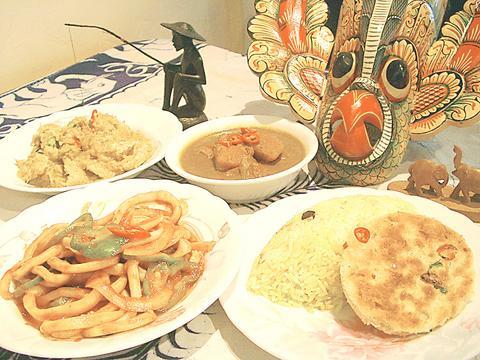On Chungshan N Rd and Chungcheng Rd in Taipei's Tienmu district, big and popular restaurants are everywhere, a sign that this foreigners' enclave has become more commercialized. But if you prefer the older look of Tienmu -- a place where you can find small, cozy houses with exotic food -- many would recommend a place like Lanka Restaurant.
Fourteen years ago, Lanka Restaurant was the first restaurant in the area to serve authentic curries. Other curry houses have come and gone, but Lanka remains, on quiet Chungyi street, near Yangming Hospital. It is still Taipei's only Sri Lankan restaurant.

PHOTO: YU SEN-LUN, TAIPEI TIMES
Owner Damian Chee (齊興盛), an overseas Chinese from Sri Lanka, settled in Tienmu with his Korean wife, Clarissa Kim (金福順). Finding it hard to find a decent curry house, Chee decided to bring Sri Lanka's home-style cuisine to Taipei.
Pumpkin curry, mutton curry and seafood curry are the most popular dishes in the house. The pumpkins have a tender and sweet taste despite being steeped in spicy gravy. It's a tasty vegetarian dish.
Apart from stew curry, Lanka also offers sauteed curry dishes. Here, the meat is sauteed with curry flavor spices and coconut meat. Dishes in this category include sauteed chicken with coconut and curry fried rice with beef. For those who are used to Chinese-style fried rice, the coconut curry flavored fried rice can offer a new taste sensation for the palate to savor.
One major feature of Sri Lankan curry cuisine is its use of coconut milk. This usually adds a smooth and sweet flavor. But it does not mean that Lanka's curries are less hot and spicy than Indian food. In fact, Lanka's "devil dishes" can give you more spice than Sichuan spicy hot pot. One peek at the red color of the dishes should give you enough warning as to the heat you are about to experience.
Chee insists on using spices brought in by his brothers from Sri Lanka and he also grows curry leaves at his Taipei home, making sure Lanka's authentic tastes are maintained.
Lanka's reasonable prices are another plus. Sharing with four, having a few different curry dishes, a few coconut roti (coconut-flavored bread, also a must-try) and yellow rice, and maybe a glass of wine, will set you back around NT$ 300 -- much cheaper than any Indian restaurant in Taipei.
Finally, don't forget the side dishes of the house. Fried eggplant is sauteed pre-fried eggplant, with spices and coconut milk. Okra Fried is a cold dish, mixing lemon juice and tomatoes with pre-fried okra. These two are favorite dishes among foreigners. A cup of Ceylon milk tea and a pumpkin pudding can make for a nice ending to the meal.
Address: 48, Chungyi St, Tienmu, Taipei (台北市忠義街48號)
Telephone:(02) 2832-0153
Open: 1am to 2pm, 5pm to 9pm (Closed Monday lunch time)
Average meal: NT$200
Details: English menu, credit cards not accepted

Exceptions to the rule are sometimes revealing. For a brief few years, there was an emerging ideological split between the Democratic Progressive Party (DPP) and Chinese Nationalist Party (KMT) that appeared to be pushing the DPP in a direction that would be considered more liberal, and the KMT more conservative. In the previous column, “The KMT-DPP’s bureaucrat-led developmental state” (Dec. 11, page 12), we examined how Taiwan’s democratic system developed, and how both the two main parties largely accepted a similar consensus on how Taiwan should be run domestically and did not split along the left-right lines more familiar in

As I finally slid into the warm embrace of the hot, clifftop pool, it was a serene moment of reflection. The sound of the river reflected off the cave walls, the white of our camping lights reflected off the dark, shimmering surface of the water, and I reflected on how fortunate I was to be here. After all, the beautiful walk through narrow canyons that had brought us here had been inaccessible for five years — and will be again soon. The day had started at the Huisun Forest Area (惠蓀林場), at the end of Nantou County Route 80, north and east

Specialty sandwiches loaded with the contents of an entire charcuterie board, overflowing with sauces, creams and all manner of creative add-ons, is perhaps one of the biggest global food trends of this year. From London to New York, lines form down the block for mortadella, burrata, pistachio and more stuffed between slices of fresh sourdough, rye or focaccia. To try the trend in Taipei, Munchies Mafia is for sure the spot — could this be the best sandwich in town? Carlos from Spain and Sergio from Mexico opened this spot just seven months ago. The two met working in the

This month the government ordered a one-year block of Xiaohongshu (小紅書) or Rednote, a Chinese social media platform with more than 3 million users in Taiwan. The government pointed to widespread fraud activity on the platform, along with cybersecurity failures. Officials said that they had reached out to the company and asked it to change. However, they received no response. The pro-China parties, the Chinese Nationalist Party (KMT) and Taiwan People’s Party (TPP), immediately swung into action, denouncing the ban as an attack on free speech. This “free speech” claim was then echoed by the People’s Republic of China (PRC),